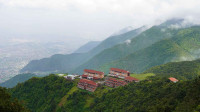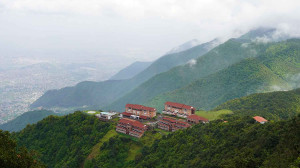Money
Nepali tea corners Darjeeling brew
As one of the world’s largest annual tea expos began in Las Vegas, the US, this week, Nepali tea producers were reminded of the bitter reality that the story of Nepal’s highland orthodox tea is still overshadowed by the much-renowned Darjeeling tea despite having an edge over the Indian product.
Rupak D. Sharma
As one of the world’s largest annual tea expos began in Las Vegas, the US, this week, Nepali tea producers were reminded of the bitter reality that the story of Nepal’s highland orthodox tea is still overshadowed by the much-renowned Darjeeling tea despite having an edge over the Indian product.
Darjeeling tea, which has a much longer history than Nepali orthodox tea, has, no doubt, carved a niche for itself in the international market and played a key role in increasing consumption of the tea worldwide. This popularity has even prompted Indian companies and traders to brand Nepali orthodox tea as Darjeeling tea in the international market because of similarity in taste and aroma.
But over the years Nepali orthodox tea has made rapid strides and risen up on the quality ladder. This is an indication that Nepali orthodox tea no longer needs to ride on the success of Darjeeeling tea, as it has created an identity of its own. No wonder, Nepali teas have bagged awards at Global and North American tea championships-events where different brands of teas are awarded based on their taste and quality.
This success has started worrying Darjeeling tea producers, according to Ilam-based Uday Chapagain, one of the largest orthodox tea producers in Nepal. A sneak peek into this brewing anxiety was given by a news article published recently in a major Indian newspaper.
The news has relentlessly taken a swing at the quality of Nepali orthodox tea, calling it “cheap” compared with Darjeeling tea. This has left Chapagain dumbfounded, as the jab comes at a time when tea connoisseurs and purveyors around the world have started “heaping praise on Nepali orthodox tea particularly because of its quality, aroma, taste and aftertaste”.
Orthodox teas are high-quality teas that are brisk and more nuanced than ordinary CTC tea, which leaves a bitter aftertaste.
“Orthodox teas produced in Nepal are even more superior in quality because our tea gardens are established in virgin lands, where farming was never conducted. Also, climatic conditions in the foothills of the Himalayas are perfect for tea plants,” says Chapagain, owner of Gorkha Tea Estate in the eastern Nepali district of Ilam, which produces around 70 tonnes of orthodox tea per year, adding, “The biggest advantage is that our tea bushes are younger, which give better harvests.”
Nepal’s tea gardens are around 60 years old or younger, whereas the big state-owned Darjeeling tea estates, established during the British rule, are more than 150 years old. Since older plants in Darjeeling give lower yields, production cost has been going up, making the tea expensive, although its texture, aroma and flavour are the same as Nepali tea if not worse.
“This is the advantage we have over Darjeeeling tea and if we can cash in on this by marketing aggressively, we can rapidly increase our footprint in the global orthodox tea market,” says Chapagain, who has been engaged in tea business for the last 30 years.
The history of Nepali tea dates back to 1862 when China first extended seeds as gifts. Around that time, Darjeeling also saw its first tea plants. But tea production came to a halt in Nepal after first harvest was reaped by the Nepal Army in 1873, while Darjeeling continued its production. It was only after the establishment of the Nepal Tea Development Corporation by the government in 1966, the country began producing tea at commercial level. This led to rapid expansion of tea gardens in the country.
Today, Nepal’s tea gardens spread across 28,000 hectares, mostly in the east, and are gradually expanding to the central and western parts of the country. These tea gardens produce over 24 million kg of tea per year, of which around 6 million kg are orthodox-which is little less than 8 million kg of orthodox tea produced in Darjeeling.
Orthodox tea gardens in Nepal, spread over 16,000 hectares, are owned by around 30,000 small farmers, many of whom plant tea on less than a hectare of land. This implies earnings made from sales of tea leaves are not only being pocketed by rich owners of tea estates as in Darjeeling but are trickling down.
So, the story behind Nepali orthodox tea is not only about plucking tea leaves, processing and packaging them, and selling the final product for a profit, but sharing prosperity as well.
This philosophy, so far, has worked well, as “small farmers engaged in production of tea are relatively well off than farmers growing other agricultural products”, says Govinda Dahal, chairman of the Central Tea Cooperatives Federation, the apex body of small tea farmers in Nepal.
This is one of the reasons why farming of orthodox tea, which was limited in eastern parts of the country, has expanded to places as far as Pokhara in the west. This competition has prompted tea factories to introduce latest technology, such as stalk extractor, which removes stalks from tea, and colour shutter, further scaling up the quality of Nepali orthodox tea.
The orthodox teas produced in Nepal are broadly divided into three categories: organic, specialty and conventional. Around 10 percent of the orthodox teas produced in Nepal are organic, while another 10 percent are specialty teas, like white tea, oolong tea, and silver and golden tip teas. The remaining 80 percent are conventional orthodox tea, meaning they are not organic.
Gradually, producers of conventional orthodox tea are turning to production of organic and specialty teas, which have greater demand in the international tea market, according to Prem Acharya of the National Tea and Coffee Development Board.
This shift in trend is expected to further raise the standard of Nepali orthodox tea, according to Chapagain. “So, the prospect of Nepali orthodox tea is bright. All we need to do is let the world know about the strengths of Nepali orthodox tea.”




 16.57°C Kathmandu
16.57°C Kathmandu















